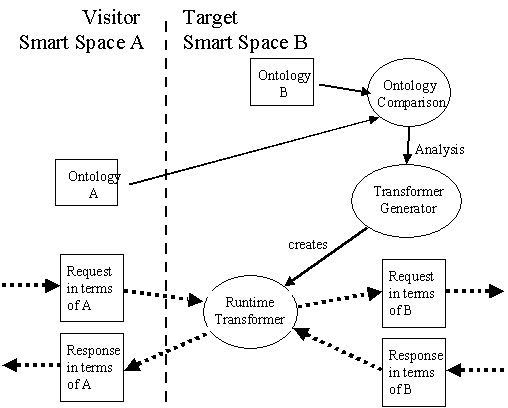 This issue in pdf Archive: |
|
|||
Negotiating on Your Own Terms!by Declan O'Sullivan and Vincent Wade In Multimedia and Hypermedia Systems the Knowledge and Data Engineering Group at Trinity College Dublin has pioneered research in virtual Web-based environments, adaptive hypermedia systems for customised or personalised user experience, usability of Web-based learning, metadata-driven (XML based) approaches for developing re-usable digital resources and XML-based digital resource discovery services in a global search context. Achieving semantic interoperability when interconnecting information systems of different parties continues to be a difficult problem. Moreover, a solution that allows for semantic interoperability to be achieved at runtime through dynamic discovery of meaning and dynamic translation between parties is increasingly needed. In particular, such a solution could have a profound impact on how e-business is conducted. For example, each party in a B2B relationship would conduct business using the natural terminology of the business, leaving the translation between vocabularies to be automatically undertaken by the system. For example, one party might call the date for delivery 'Due Date' with the format 'Day/Month/Year' and the other party calls it 'Delivery Date' with format 'Month/Day/Year'. Such interoperability issues have been dealt with in the past at schema design time (with distributed database solutions), through the hand-crafting of interoperability gateways (with system integrator solutions) or by forcing each business to conform to a standard vocabulary (eg ebXML). Of course, the difficulty comes as the nature of each business and their respective ontologies evolve over time. More and more what is required is the runtime comparison of ontologies and the dynamic construction of gateways. Research that is being undertaken within the Knowledge and Data Engineering Group of Trinity College Dublin looks at finding such a solution, and draws upon ongoing research into the Semantic Web, ontologies, electronic negotiation, and dynamic adaptation of software systems. The chosen application area, which provides a rich source of requirements, is the management of ubiquitous computing/smart spaces environments. A Smart Space is a physical space rich in devices and software services that is capable of interacting with people, the physical environment and external networked services. The aim of the Smart Space is to bring tangible benefits to people in support of their tasks and activities. Take for example, a cardiac surgeon who is woken by her alarm clock. Upon sensing that she has got up and is having a shower, the home smart space sends messages to the coffee machine, toaster and fruit press appliances to have breakfast ready. Her PDA is activated and downloads any emergency case patient files that may have arrived overnight, and alters the day's appointment and work schedule if necessary. Upon leaving the house, the home management system configures the intruder alarm, the call forwarding/answering service and utility management services accordingly. The primary objective of smart space management is the dynamic runtime adaptation of smart space devices and software services to provide the necessary support for people's tasks and activities. In addition it involves the lifecycle and operational management of the devices and services offered by the smart space. Today's computers interact with users in terms of low level abstractions - applications and individual appliances. A smart space will take over most low level management of applications and appliances so that the user interacts in terms of 'activities' (that represent user intent). In this scenario, it cannot be assumed that ordinary users will limit their expressions to a set of standardised activities. Indeed this would run contrary to the intent of smart spaces to support users to perform their activities seamlessly and efficiently. Where a user is confined to a single operator domain, it can be foreseen how the smart space can learn which user-specified activities can be mapped to which smart space services, and which of those services can be executed simultaneously without conflict at runtime, in accordance with policies set for that space. However, in order to enable the free movement of users between smart spaces, information must be made available to the visited smart space regarding which equivalent or adapted services the user will want to avail themselves of, and what quality of service will be expected/agreed to. Each smart space will want to negotiate using the activity/service and contracting terminology that is most familiar. This results in the need to 'bridge' between the terminology of each party during the negotiation of the necessary service level agreements. However, given the wide diversity of users, smart space capabilities and smart space operators envisaged in the future, the negotiation of such service level agreements needs to be automatic, with human intervention being a very exceptional case.
One solution being researched in the group involves a platform that uses Semantic Web technologies to dynamically bridge the terminologies of the two parties at runtime. First the ontologies of the two parties (represented in XML Topic Maps) are compared. The comparison of the ontologies is then used to derive XML stylesheets that transform the negotiation from one party's terminology to the other party's terminology and vice versa. This comparison and dynamic bridging is undertaken at runtime and requires no a priori knowledge of the party requesting the service level agreement. Key to our approach is that each ontology needs only to adhere to a small subset of common concepts, with the rest of the ontology being defined to reflect the terminology most natural for the particular smart space. The approach is illustrated in the Figure. This work is undertaken as part of the Irish government HEA funded M-Zones project. The M-Zones Research Programme is a multi-disciplinary, inter-institutional research programme that engages in fundamental research in Management and Control systems for integrating Multiple Smart Spaces. Link: Please contact: |
|||


